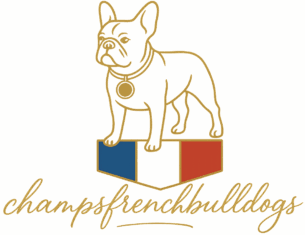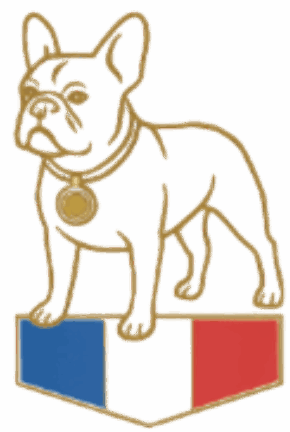Raw Feeding French Bulldogs
At Champs French Bulldogs, we’ve lived with dogs our whole lives and across many breeds—from farm days with Italian Mastiffs to today’s family of Frenchies. Over the years we saw the same pattern: when we improved nutrition, dogs looked, moved, and felt better. Long before “raw” was trendy, we learned it the hard way. A pit bull we owned decades ago struggled with allergies and a strange gait on a bargain kibble that listed corn up top. We upgraded the food (no corn), symptoms eased. Later, we tried adding raw—coat went glossy, dandruff vanished, movement looked smoother, energy was cleaner. That kicked off our slow, practical journey into raw feeding for French Bulldogs.
This page shares what we do and why. It isn’t a scientific paper or a one-size-fits-all prescription. It’s our program, built with our vets, shaped by countless meals, litters, and miles of walks.
Why We Feed Raw for Our Frenchies
French Bulldogs are compact, muscular, and sensitive to extra weight. We’ve found that clean, measured, protein-forward meals help keep body condition lean, which in turn supports easier breathing, lighter movement, calmer skin, and better stools. In our experience, some ultra-premium kibbles still rely on grains (often corn) and fillers that didn’t serve our dogs as well. When we supplemented with raw several times a week, we noticed:
-
Glossier coats and healthier skin (zero “snowflake” dandruff)
-
Steady, “clean” energy without sugar highs/lows
-
Easier weight control and a visible waistline
-
More athletic, confident movement in everyday life
We’re not claiming raw cures medical conditions. We’re saying that nutrition matters, and in our kennel, adding raw (properly, safely, and measured) has consistently helped our Frenchies thrive.
What “Raw” Means to us
We keep it simple and safe:
-
Quality first. Human-grade, fresh proteins; no mystery meats.
-
Measured portions. We weigh meals to protect body condition.
-
Balanced over time. We aim for variety across the week rather than perfection in every bowl.
-
Vet-guided adjustments. Puppies, seniors, and pregnant/nursing females get tailored plans.
Yes—when a mama is pregnant (like our girl “Victoria’s Secret”), we’ll offer small raw additions that our vet is comfortable with. We separate mealtimes (raw is a high-value food), keep manners tight, and never tolerate resource guarding.
How Often & How Much
From the video: even adding raw a few times per week made a difference for us. For adult Frenchies we like two small meals daily; raw can be part of either meal on 3–4 days/week (or daily, if you’ve fully transitioned and balanced the diet). We adjust portions slowly and watch body condition like hawks. Puppies are different—puppies must be well-fed with age-appropriate calories and calcium/phosphorus balance.
A Simple Starter Approach
If you’re easing in, start modestly for an adult Frenchie:
-
Add a small topper of raw beef or turkey to the regular meal a few times/week.
-
Keep bowls spotless; handle raw with kitchen-grade hygiene; freeze/thaw safely.
-
Watch stools, skin, breath, energy, and—most importantly—body condition.
-
If your vet approves, you can later add single-ingredient extras (e.g., a raw egg, sardines in water, measured fish oil).
-
We avoid cooked bones (splinter risk) and only use raw meaty bones under veterinary guidance.
If your dog is overweight, reduce total calories first, then add low-impact activity. Raw alone won’t fix an overfed bowl. For a quick visual guide to body condition, compare with a trusted chart before changing amounts:
Heat, Walks, and Naples, Florida
Activity matters, but we keep it Frenchie-smart—especially in Naples, Florida:
-
Short, shaded walks at sunrise/sunset; skip midday heat.
-
Water breaks, a pavement test (back-of-hand 5–7 seconds), and AC cooldown after.
-
We even use a dog stroller for seniors or mid-walk cooldowns. It looks funny—works great.
Joints, Weight & Raw
Extra pounds magnify everything you don’t want: joint strain, breathing effort, back stress (IVDD), skin fold issues. If you’re trimming weight or keeping a lean athlete, consider joint support alongside diet. We explain exactly what we use—Glucosamine, chondroitin, MSM—and when we reach for NuVet’s joint line here: Hip & Joint Supplements for French Bulldogs
Safety Notes (the stuff we never skip)
Raw feeding demands kitchen hygiene: separate cutting boards, clean counters, wash hands/bowls, and thaw safely. Confirm with your vet if your dog is immunocompromised, on medication, or recovering from surgery. Puppies, pregnant, and senior dogs deserve vet-tailored plans. If something looks off—loose stools, lethargy, skin flare—pause and call your vet. This page reflects our experience; it’s not medical advice.
Transition Tips From us
Switch slowly over 7–14 days if you’re moving from kibble to partial raw. Keep treats simple and count them in the calorie budget. If your Frenchie gets “picky,” it’s often learned. Go back to measured meals, remove free-feeding, and keep routines calm and consistent. Two weeks of consistency fixes most “sudden picky eater” phases.
FAQ
Do I have to go 100% raw?
No. We started by adding raw several times per week and still saw great results.
Is kibble bad?
There are good kibbles and less-good ones. What mattered for our dogs was ingredient quality, measured portions, and keeping body condition lean.
Can I mix raw and kibble?
Many families do. Transition gradually and watch your dog. Your vet can help tailor the plan.
What about bones?
We avoid cooked bones (splinter risk). Raw meaty bones are a “maybe” only with vet guidance and strict supervision. We do just fine without them.


